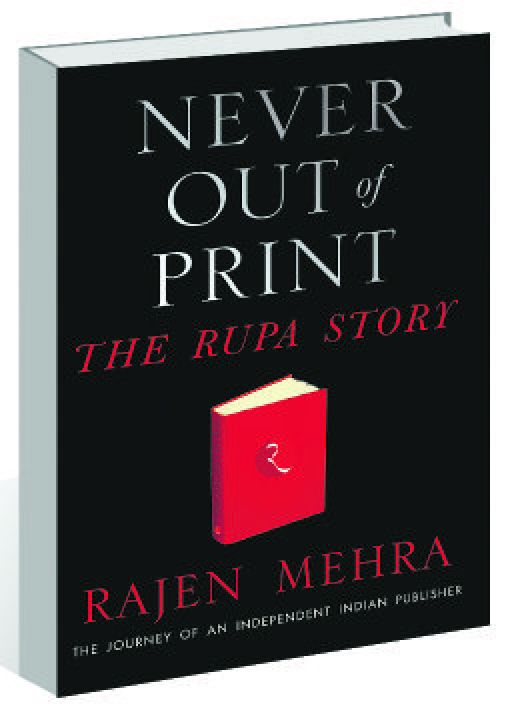Never Out of Print: The Rupa Story by Rajen Mehra. Rupa. Pages 504. Rs 500
Book Title: Never Out of Print: The Rupa Story
Author: Rajen Mehra
Debashish Mukerji
Rupa & Co is a book distribution and publishing pioneer which — almost alone among such pioneers, at least in the English language — has successfully adjusted to the enormous changes the industry has undergone across the decades and continues to remain a heavyweight in the field. It began with Daudayal Mehra — whose family migrated from Peshawar to Lahore to Amritsar to Varanasi to Kolkata in the late 19th century — moving away from the family hosiery business to spread an old bedsheet across part of the pavement opposite Kolkata’s renowned Presidency College on August 17, 1936, and selling English books instead. The name Rupa, which came later, derived from a play Daudayal Mehra had watched in Kolkata and been captivated by, where the main female characters were called Sona and Rupa.
In this book, Rajen Mehra, grandnephew of Daudayal Mehra, who set up Rupa’s first Delhi office in 1970, and has been running the business since his granduncle Daudayal and father ND Mehra retired/died, documents the fascinating rise of this publishing house, as also his interactions with his bestselling authors and the celebrities whose autobiographies Rupa has published. Interspersed with scores of photographs and several excellent illustrations as well, ‘Never Out of Print’ is much more than Mehra’s autobiography. It is a riveting social history of India through much of the 20th and early 21st centuries from a publisher’s perspective.
He writes: “As I look back in time, I am filled with wonder: starting from a small street corner in 1936, we branched out to Allahabad in 1939, Bombay in 1954, followed by Delhi in 1970. I wonder how we managed to sell books, first across India and now globally. What started with importing foreign titles, then acquiring the rights for these titles, reprinting, joint ventures with global giants, and finally independent publishing, Rupa’s metamorphosis elicits both awe and humility in all of us.”
Born in 1947, Rajen Mehra initially intended to join an IIM and pursue an independent corporate career, but as luck would have it, his college years coincided with the height of the Naxalite movement in Kolkata in the late 1960s. The university was almost indefinitely closed, following “the unending series of student bandhs and strikes and violence on campus”, as Mehra puts it. His granduncle then suggested Mehra “come and sit in his office and get a sense of the book business”.
By then, Rupa had moved from bookselling to book publishing as well (in 1960) and had offices around the country with “exclusive and non-exclusive distribution rights of 24 British publishers”. Mehra did so, and following a tour of Rupa’s various offices on which his granduncle shortly sent him, “gone were my frustrations and disillusionment with the educational system… I was swept away by the prospects and challenges that a career in publishing held out… It was 1969, I was 22, and I knew without a shadow of doubt what I wanted to do for the rest of my life”. The irresponsible trade unionism the Left Front government in West Bengal — which came to power in 1977 — encouraged, led to Rupa eventually shutting its Kolkata operations and shifting headquarters to Delhi, where Rajen Mehra was already based.
From the start, Rupa’s path crisscrossed that of celebrities — following the Quit India movement of 1942, Daudayal Mehra, who had set up Rupa’s first office outside Kolkata in Allahabad (now Prayagraj) in 1939, supplied books to Jawaharlal Nehru and other Congress leaders imprisoned in nearby Naini jail (and got into trouble with the British authorities for doing so). Thereafter, within a few years, when Nehru’s ‘Glimpses of World History’, written during his incarceration in various jails, was published by British publishers Allen and Unwin, Rupa acquired its Indian distribution rights. It proved a huge bestseller, selling “so many copies that we built our Allahabad home using profits made off it”!
Other celebrity autobiographies Rupa has published include Lal Krishna Advani’s ‘My Country, My Life’, Gayatri Devi’s ‘A Princess Remembers’, K Natwar Singh’s ‘One Life Is Not Enough’, and, above all, Sunil Gavaskar’s ‘Sunny Days’, which turned out to be a perennial bestseller, going into 31 reprints (the last in 2023) since its first publication in 1976. Gavaskar went on to write a series of books for Rupa, all of which sold exceedingly well. An unexpected success was Jaswant Singh’s historical study, ‘Jinnah: India-Partition-Independence’, published in 2009, which took a more rounded view of Mohammed Ali Jinnah than his party — the BJP, which always cast Jinnah in a villainous mould — could tolerate. It led to the shocking expulsion of the senior leader from his party, but, as a result, the book sold exceedingly well.
Among the writers whose works Mehra fondly recalls publishing or distributing are Ruskin Bond (tongue-tied before a crowd, but great at one-on-one interactions); Gulzar (whose translations into English were first published by Rupa); Salman Rushdie (500 copies of whose ‘The Satanic Verses’ he had imported before the Indian government banned the book, each one of which he then collected from showrooms in Delhi and stuffed in his car boot for fear that the showrooms may be vandalised); and above all, his homegrown discovery, Chetan Bhagat.
Particularly captivating is the detailing. Mehra is clearly blessed with an extraordinary, almost eidetic, memory, which enables him to recount significant events from his own, and Rupa’s, life that occurred ages ago, with startling immediacy. He has a storyteller’s knack for holding attention with his fluid, lucid style, making one wish that, as a person who spent a lifetime among books, he had written a few more himself.














